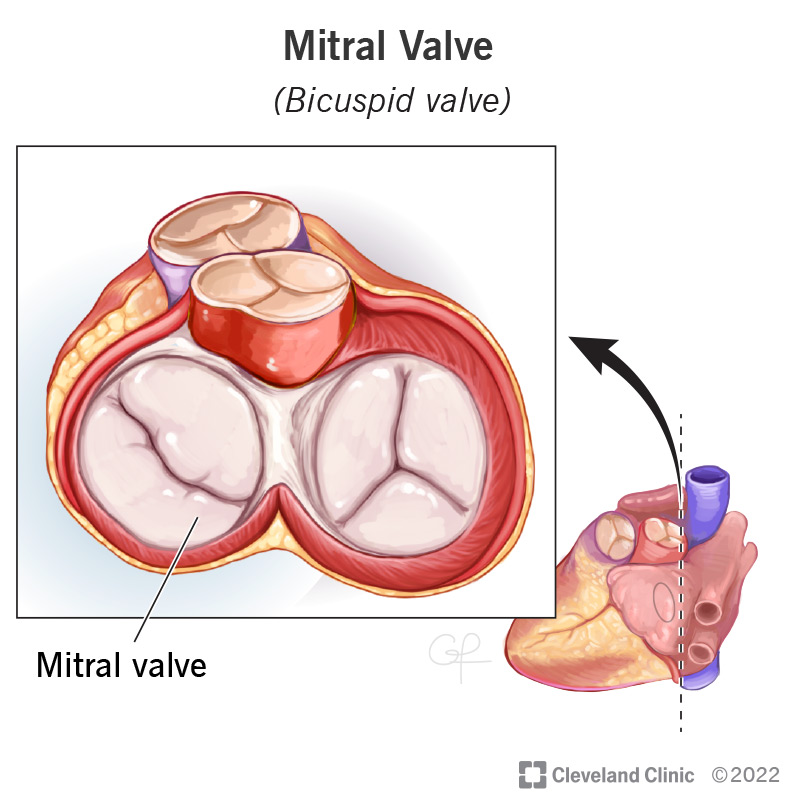Your mitral valve sits between your upper and lower left heart chambers. It opens to let blood flow from your left atrium to your left ventricle. When it closes, it prevents blood from moving backward. Sometimes, your mitral valve doesn’t work right because it’s too narrow or leaky. This can make your heart work harder to pump blood to your body.
Advertisement
Cleveland Clinic is a non-profit academic medical center. Advertising on our site helps support our mission. We do not endorse non-Cleveland Clinic products or services. Policy
The mitral valve is one of four valves in your heart. It’s located between your heart’s upper left chamber (left atrium) and lower left chamber (left ventricle). Your mitral valve opens and closes to make sure blood flows in the correct direction. The left atrioventricular valve is another name for it.
Advertisement
Cleveland Clinic is a non-profit academic medical center. Advertising on our site helps support our mission. We do not endorse non-Cleveland Clinic products or services. Policy
Your mitral valve is important because it lets oxygen-rich blood get to your left ventricle. Your left ventricle is the pump that pushes the blood out to your body so your tissues can get oxygen and nutrients.
You may not give much thought to your mitral heart valve until you have trouble with it. But it’s comforting to know that healthcare providers can offer a variety of treatments for mitral valve issues.
Your mitral valve’s function is to open and close. Your heart pumps blood in a specific route through four chambers (two atria and two ventricles). As your heart pumps, valves open and close to allow blood to move from one area of your heart to another. The valves act as doors that open and close between the chambers. The sound of a heartbeat is the sound of your heart’s valves opening and then closing.
The valves help ensure that blood flows at the right time and in the correct direction. The function of your mitral valve is to make sure that blood flows from your left atrium to your left ventricle. It also ensures that blood doesn’t flow backward from your left ventricle to your left atrium.

Your mitral valve is located between the upper left chamber of your heart (the left atrium) and the lower left chamber (the left ventricle).
Advertisement
The main part of your mitral valve anatomy has two thin but strong tissue flaps (leaflets). Providers call them the anterior leaflet and the posterior leaflet. With every heartbeat, the leaflets open and close.
The leaflets attach to the papillary muscles of your left ventricle with thin, strong cords (chordae tendineae). There’s an area called the zone of coaptation that describes the portion of the leaflets that touch when the valve is closing. Maintaining a proper zone of coaptation is important to a well-functioning valve.
The leaflets also attach to the mitral annulus. The annulus is a D-shaped junction connecting the tissue of your left atrium to the tissue of your left ventricle.
You can picture something like a parachute when thinking about the anatomy of your mitral valve. Your mitral valve anatomy looks like two separate leaflets (one larger than the other) inside one saddle-shaped ring. When the two leaflets come together, they look like a closed-mouth smile. Your mitral valve has a diameter about as wide as a small paper clip.
The chordae tendineae look like strings of dental floss that connect the muscles below them to the leaflets above them. The papillary muscles and chordae tendineae work to move your valve’s leaflets.
When your mitral valve doesn’t function properly, your heart has to work harder to pump enough blood to the rest of your body.
It may not function properly because of:
Your mitral valve can have a variety of different issues:
Advertisement
A mitral heart valve condition may not cause any symptoms at all for many years. But it can get worse over time, so symptoms may appear as you get older. They may include:
Serious mitral valve conditions may lead to life-threatening problems, like:
Because of these serious complications, it’s important to see your healthcare provider as soon as possible if you develop any signs of mitral valve issues.
Tests providers use to check your mitral valve’s health include:
The optimal treatment for mitral valve disorders depends on the type of problem. If you have issues with your mitral valve, your provider may treat them with:
Advertisement
You may not be able to prevent a mitral heart valve problem. But you can take action to help keep your heart healthier:
If you have a mitral valve condition, it’s important to have regular checkups with your primary care provider or cardiologist. They’ll monitor your heart and lungs to detect any complications early and provide treatment. You should also take all your medications exactly as prescribed to prevent complications.
If your mitral valve isn’t doing its job as well as it should, your heart may be working too hard. This can cause symptoms that a provider will need to treat. The good news is that many treatment options can ease the symptoms and prevent or delay complications. With today’s medical advances, treatment may be less invasive than you think. Take charge of your health and ask your provider about your options.
Advertisement
Problems with your heart can be scary. Our experts can diagnose and treat mitral & tricuspid heart valve disease.

Last reviewed on 08/12/2024.
Learn more about the Health Library and our editorial process.